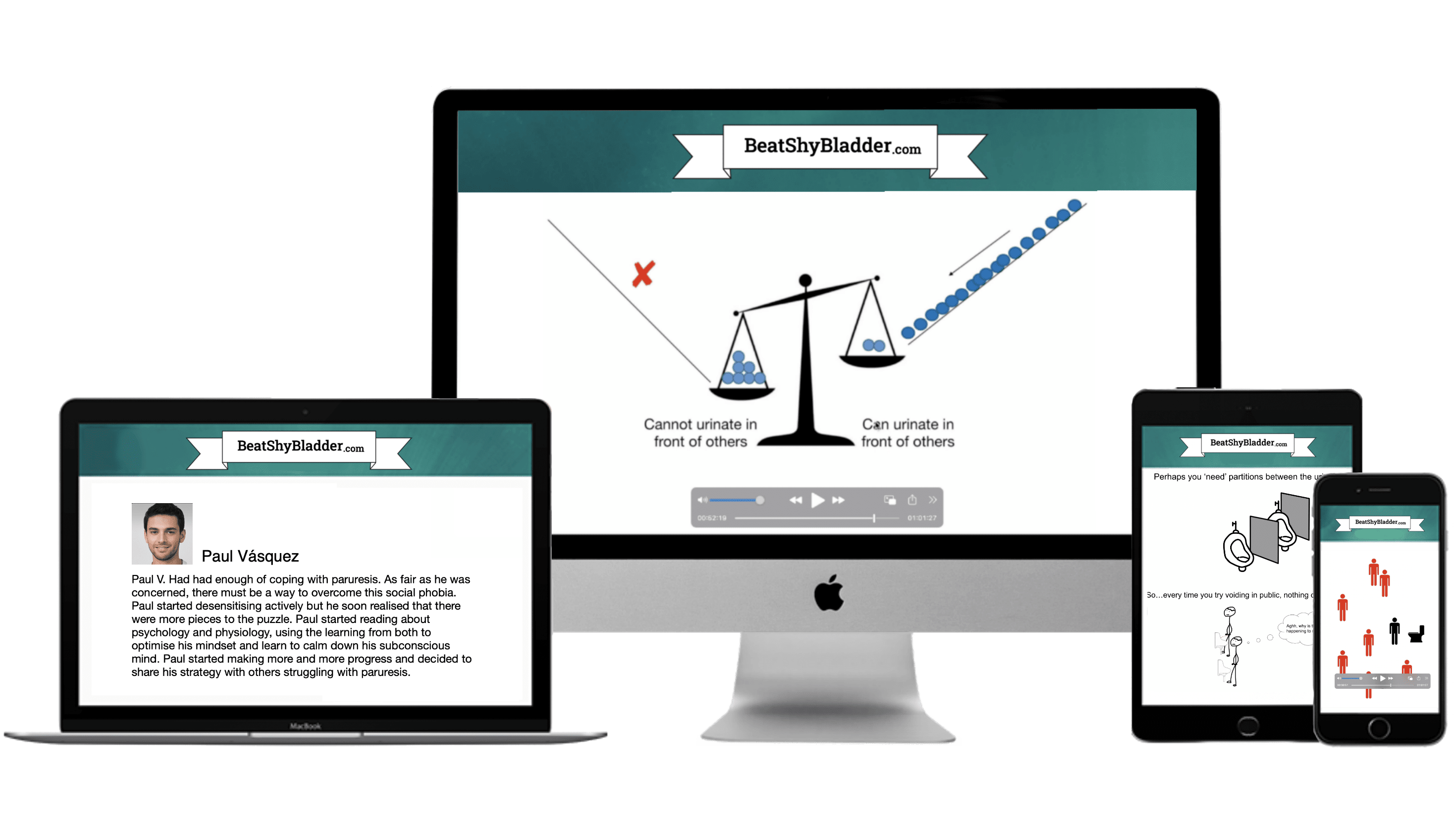Boom-boom, boom-boom, boom-boom…
We all know our hearts beat to pump blood around our body. But how does our heart rate and beating pattern relate to our resilience and ability to manage stress?
More importantly, can we consciously influence our physiology to help us overcome shy bladder syndrome?
What is heart rate variability?
Heart rate variability (HRV) is the change in the time elapsed between each heart beat. This is not to be confused with heart rate which is a measure of the frequency of your heart beats.

It turns out that HRV is the primary measure of our adaptability and resilience to stress. “Heart rate variability (HRV) is one of the most important physiological measures of mental health” – (Hartmann et al. 2019)

From the diagrams above, we can see that our heart rate is constantly changing. As we breathe in, our heart rate goes up and as we breathe out, our heart rate goes down.
We can also see that over a period of 60 seconds, two people could have the same average heart rate but significantly different heart rate variability. Whereas the heart rate on the left has a large amplitude (increases and decreases significantly with the in and out breaths), the heart rate on the right resembles a metronome with a low amplitude.
But why does this matter?????????????? And how can this help you become more comfortable in public restroom environments?
Well, higher average HRV is associated with a more flexible nervous system, therefore achieving greater:
- Emotional resilience
- Mental performance
- Resilience
- Physical health
In other words, increasing your average HRV can give you an edge in managing trauma, anxiety and social phobias such as paruresis or pee shyness.
5 to 10 minutes of daily heart rate variability training might therefore be something for you to consider and integrate into your daily routine.
It is worth mentioning that heart rate variability training (routines and habits that help you increase your HRV) is not a miracle cure however, it can certainly be a helpful addition to your routine.
How to increase HRV?
Breath work exercises
Our breathing patterns are a gateway into our HRV. Most of the time, we breathe subconsciously, without even thinking about it. Luckily, we can take over the auto-pilot and control our breath rate. If we consciously practice breathing a certain way each day, this will become how we breathe subconsciously too.
In order to increase HRV, we want to breathe in such a way that we experience the greatest change in heart rate as we breathe in compared to when we breathe out. This is called resonance frequency breathing.
For the average adult, resonance frequency breathing involves taking 4 to 7 breaths per minute. (Yes, a lot of us are over-breathing!).
You can practice resonance frequency breathing by taking 5 to 10 minutes daily to:
- Breathe in for 4 seconds
- Breathe out for 6 seconds
- Repeat
This exercise will result in 6 breaths per minute. Remember to:
- Breathe through your nose
- Do diaphragmatic (belly) breathing
- Take normal sized breaths
Longer exhales cause the vagus nerve to send a signal to your brain, activating the parasympathetic nervous system (rest and digest) and easing the sympathetic nervous system (fight, flight, or freeze).
Breathe to increase heart rate as much as possible on the in-breath and down as much as possible on the down breath. Over time, this is training your nervous system to become more flexible and resilient.
Bear in mind, that you can reserve this breathing pattern for practice and times of stress. It is not the case that you have to maintain this breathing at all times. For instance, when working out, you may have to increase your breath rate!
If you would like to learn more about other breathing patterns and how they can help you overcome shy bladder syndrome, you can check out this blog post here.
Biofeedback
The breath exercise explained above can be done for free. However, if you would like to measure your HRV and visually track your progress over time, there are a few HRV monitors and biofeedback devices on the market.
Biofeedback devices measure the variation in time between your heartbeats in real time.
As you get real-time feedback on your HRV, you learn how to consciously change it. You do this by trying different things, like thinking positive thoughts, changing your breathing rate, and so on to see how your behavior affects your HRV.
With this kind of immediate feedback, you can learn very quickly what works for raising your HRV.
After a few training sessions, getting into high HRV will become second nature. You’ll know what habits increase your HRV and you’ll be able to raise your HRV at will.
Cold exposure
Cold plunges or cold showers are a reliable way of increasing your HRV. By activating the fight or flight response, we become more accustomed to it and improve our HRV.
This is a form of hermetic stress (i.e. stress that makes you stronger as opposed to stress that makes you weaker). By subjecting ourselves to an uncomfortably cold environment (e.g. ice bath or cold shower), we build resilience that then results in increased HRV1.
Note that as you become accustomed to colder temperatures, exposure to even colder temperatures will be needed to keep increasing your HRV. The shock factor is important here.
Furthermore, cold exposure stimulates the vagus nerve which helps combat low moods!
Summary:
- Exposure to temperatures cold enough to ‘scare’ you can increase HRV
- This can also improve mood and energy
- Don’t overdo it…obviously. Use common sense.
Adequate sleep
Various studies have linked lower sleep quality with lower HRV2.
It is worth mentioning that increasing your sleep quality will not be a miracle cure for overcoming pee shyness. However, improving your sleep quality can increase various health parameters (including HRV) which can give you an edge and decrease the fight or flight response typically triggered in public restrooms for people experiencing shy bladder syndrome.
You can improve your sleep quality by:
- Having a regular sleep schedule
- Getting enough sleep
- Avoid consuming large amounts of alcohol or food right before going to sleep
- Sleep in a dark room
- Dim the lights you are exposed to a couple of hours before bed
Good nutrition
I won’t claim that any one diet is the ultimate ‘solution’ to overcoming shy bladder syndrome.
That being said, HRV is a measure of our mental resilience (which can help you maintain a sense of calm and indifference in public restrooms). Given that HRV a measure of the health of our autonomic nervous system, it makes sense that eating inflammatory foods that damage this system may make your road to recovery from paruresis an uphill battle.
Given that different people may have different food sensitivities or allergies, the optimal diet may look somewhat different for each person. That being said, avoiding excessive inflammatory foods such as sodas, sugar and trans fats (junk food) may give you a slight edge.
Limit alcohol consumption
Alcohol consumption has also shown to reduce vagal activity (this is bad. The vagus nerve is a key component of the parasympathetic nervous system – associated with states or ‘rest and digest’)3.
Naturally, the greater the alcohol consumption, the greater the effect on heart rate and HRV.
Let’s be honest, the key to overcoming shy bladder syndrome is not to cut out alcohol and hope for the best. Desensitisation via exposure therapy will likely be an integral part of your recovery protocol.
However, if you want to gain an edge, limiting alcohol consumption may be a wise thing to do.
To your success, you got this!
Overcome Shy Bladder Syndrome Today
Get your hands on the time tested Beat Shy Bladder Blueprint
- Self Auditing
- Protocol Reviews
- Knowledge Trove
- Feedback Loops
- Heart Rate Variability
- Visualisation
- Mindset Upgrade
- Desensitisation





I fully share your opinion. I think it is a good idea.
Never even considered HRV. Very useful, thanks for sharing
Ditto, just wish biofeedback devices in the market were better/more affordable
Never realised there was a difference between Hr and HRV.
Thank you for creating this post, it gives me hope that I’ll be able to make progress.
Hey Mira, would you like to connect with a fellow gal to make progress together? Good luck!
Bravo, this thought will come in handy